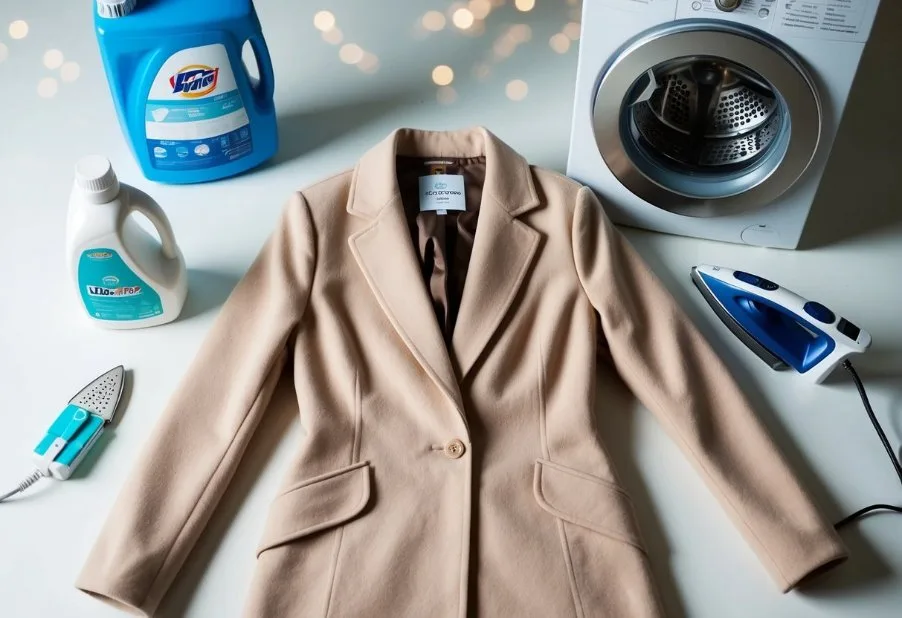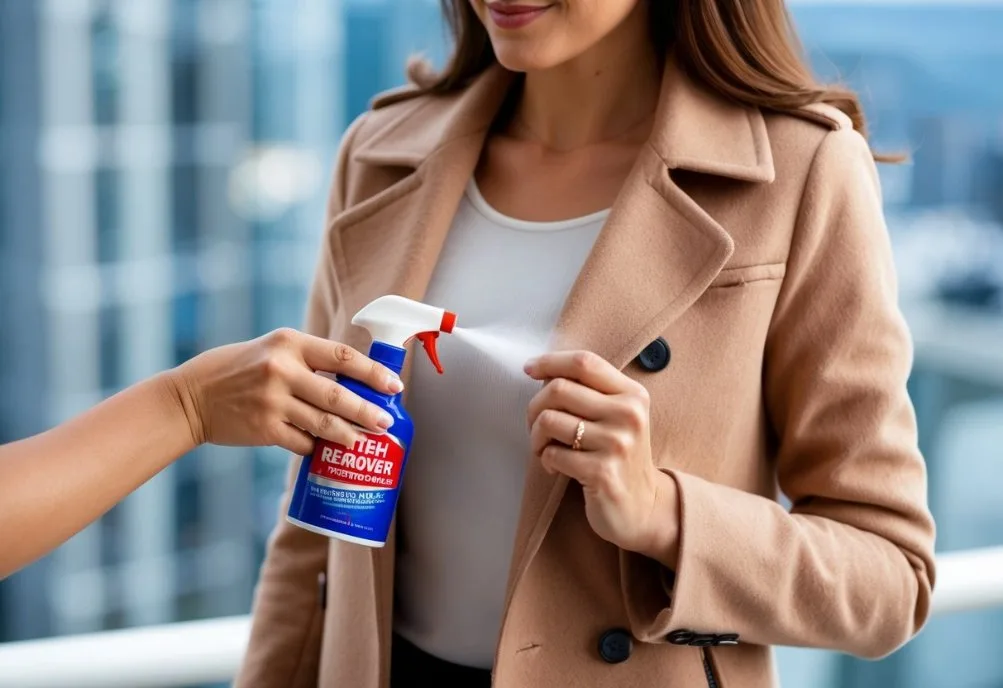Taking care of women’s coats is key to keeping them looking great and lasting longer. I’ve learned some useful tips for caring for different types of coats over the years. The most important step is to check the care label and follow its instructions carefully. This will help you avoid damaging your coat when cleaning or storing it.
Cleaning your coat regularly keeps it fresh and extends its life. For most coats, spot cleaning small stains works well. If the coat needs a full wash, use the right method for its fabric. Some coats can go in the washing machine, while others need dry cleaning. After cleaning, make sure the coat dries fully before storing it.
Proper storage is also crucial. I hang my coats on sturdy hangers and keep them in a cool, dry place. For long-term storage, I use breathable garment bags to protect them from dust and pests. Taking these steps helps my coats stay in great shape year after year.
Table of Contents
Key Takeaways
- Check care labels and follow instructions for each coat
- Clean coats regularly using the right method for the fabric
- Store coats properly in cool, dry places using appropriate hangers and bags
Identifying Your Coat’s Material

Knowing your coat’s material is key to proper care. I’ll explain how to spot different fabrics and their unique needs.
Understanding Wool and Synthetic Fabrics
Wool coats have a distinct texture – slightly rough and fuzzy. I can easily spot wool by its warmth and natural wrinkle resistance. Synthetic fabrics like polyester feel smoother and lighter. To test, I rub the fabric between my fingers. Wool feels warm, while synthetics often feel cool.
Wool coats need gentle care. I avoid washing them too often. When needed, I use cold water and mild soap. Synthetic coats are usually easier to clean. I can often machine wash them on a gentle cycle.
Natural fibers like cotton and linen are less common in winter coats. They feel soft but don’t insulate as well as wool or synthetics.
Special Care for Down Coats and Faux Fur
Down coats are super light and fluffy. I can tell it’s down if it compresses easily and bounces back. These coats need special washing to keep the feathers from clumping.
I wash my down coat in a front-loading machine with a gentle detergent. I use tennis balls in the dryer to fluff it back up.
Faux fur coats have a distinct look and feel. The “fur” is usually made from acrylic or polyester. I never put faux fur in the dryer. Instead, I let it air dry and brush it gently to keep it soft.
For both down and faux fur, I’m extra careful with cleaning. I often spot clean small stains to avoid full washes.
Reading and Interpreting Care Labels

Care labels provide crucial information on how to properly clean and maintain women’s coats. These small tags contain symbols and instructions that can make a big difference in keeping your coat looking its best.
Decoding Symbols and Instructions
I always check the care label before washing or cleaning my coat. The label usually has symbols for washing, drying, ironing, and dry cleaning. For washing, I look for a washtub icon. If it’s crossed out, I know not to machine wash the coat. A hand in the washtub means hand-wash only.
For drying, I check for a square symbol. Dots inside show the heat level – more dots mean higher heat. A circle means dry clean only. If there’s a “P” inside, it tells me which solvents to use.
I pay attention to any words on the tag too. They may say “Dry clean only” or give special instructions. By following these symbols and notes, I keep my coat in great shape for years to come.
Effective Cleaning Techniques

Keeping women’s coats clean helps them look great and last longer. I’ll cover different methods to clean coats properly at home or with professional help.
Machine Washing with Care
I always check the care label before machine washing a coat. For washable coats, I use cold water and the delicate cycle. I add a small amount of mild detergent made for delicates. To protect the coat, I put it in a mesh bag before washing.
I never use hot water or harsh detergents. These can damage the fabric or lining. After washing, I reshape the coat while damp. I lay it flat to air dry.
For puffy coats, I use tennis balls in the dryer on low heat. This helps fluff up the filling. I’m careful not to overdry, as this can harm the fabric.
Hand-Washing Best Practices
I hand wash delicate coats in lukewarm water with gentle soap. I fill a tub with water and add a small amount of mild detergent. I dunk the coat and gently squeeze the soapy water through it.
I don’t twist or wring the coat. This can stretch or damage the fabric. I rinse thoroughly in cool water until all soap is gone. To remove excess water, I press gently with a towel.
I reshape the coat while damp and lay it flat to dry. For wool coats, I use a sweater drying rack to keep the shape. I never hang wet coats, as this can stretch them out.
Professional Cleaning and Why It Matters
I take coats with “dry clean only” labels to a pro cleaner. They have special solvents and methods to clean delicate fabrics safely. This is key for wool, cashmere, and leather coats.
Pro cleaners can also tackle tough stains without damaging the coat. They know how to clean linings and preserve coat structure. After cleaning, they press the coat to restore its shape.
For valuable or vintage coats, pro cleaning is best. It helps prevent shrinkage, color fading, and fabric damage. I view it as an investment to keep my favorite coats looking great for years.
Stain Treatment and Prevention

Keeping coats free of stains takes quick action and the right methods. I’ll cover effective spot-cleaning and stain removal techniques to keep your coat looking fresh.
Spot-Cleaning Techniques
I always start by blotting the stain with a clean cloth to absorb excess liquid. For oily stains, I sprinkle cornstarch or talcum powder to soak up the oil before brushing it off.
To treat water-based stains, I mix a small amount of gentle detergent with cool water. I dab this solution onto the stain with a white cloth, working from the outside in.
For ink stains, I use rubbing alcohol on a cotton swab. I’m careful to test it on an hidden area first to check for colorfastness.
White vinegar works well on light stains and odors. I dilute it with water and apply it sparingly with a cloth.
Using Stain Removers Effectively
I pre-treat visible stains as soon as possible. This stops them from setting into the fabric. I apply a small amount of stain remover directly to the spot.
I gently work the product into the stain with my fingers or a soft brush. It’s important not to rub too hard, as this can damage the fabric.
I let the stain remover sit for about 5 minutes before washing. For delicate coats, I rinse the treated area with cool water instead.
Some stains may need multiple treatments. I’m patient and repeat the process if needed. For tough stains, I might try a specialized cleaner made for the specific type of fabric.
Proper Drying and Storage

Drying and storing women’s coats correctly keeps them looking great for years. I’ll share tips on drying methods that protect fabrics and storage techniques to maintain shape and freshness.
Drying Without Damage
I always avoid the dryer for most coats. Heat can shrink or damage delicate fabrics. Instead, I use a drying rack or padded hangers. For wet wool coats, I gently press out excess water with a towel. Never wring or twist.
I air-dry coats in a well-ventilated spot away from direct heat or sunlight. A fan helps speed drying and prevents musty smells. For puffy coats, I toss in a few dryer balls to fluff the filling as it dries.
Before storing, I make sure coats are 100% dry inside and out. Damp spots can lead to mold or mildew.
Storing Coats for Longevity
I clean coats before storage to remove stains and odors. Fabric softener isn’t needed and can leave residue.
For hanging storage, I use wide, padded hangers to keep shoulders in shape. Breathable garment bags protect from dust while allowing air flow.
I fold bulky coats loosely and store flat in plastic bins under the bed. This prevents crushing.
I add cedar blocks or lavender sachets to ward off moths and keep coats fresh. Avoid mothballs – they’re toxic and leave strong odors.
I check stored coats every few months. This lets me air them out and catch any issues early.
Maintenance and Long-Term Care

Taking good care of your coat extends its life and keeps it looking great. Regular upkeep and proper storage between seasons make a big difference.
Removing Pilling and Lint
I use a fabric shaver to remove pesky pills from my coat. It’s quick and easy. For lint, a clothing brush works well. I brush in one direction to lift off fuzz and debris.
For stubborn lint, I roll tape around my hand with the sticky side out. Then I pat the coat to pick up any remaining bits.
Refreshing Coats Between Seasons
I air out my coat before storing it. I hang it outside on a breezy day to get rid of any odors. For spot cleaning, I mix a little Woolite with cool water. I dab the solution on stains with a clean white cloth.
Before putting my coat away, I make sure it’s totally dry. I use padded hangers to keep the shoulders in shape. I store it in a breathable garment bag to protect it from dust.
I add cedar blocks to ward off moths. Every few weeks, I take my coat out and give it a gentle shake. This helps prevent creases.

